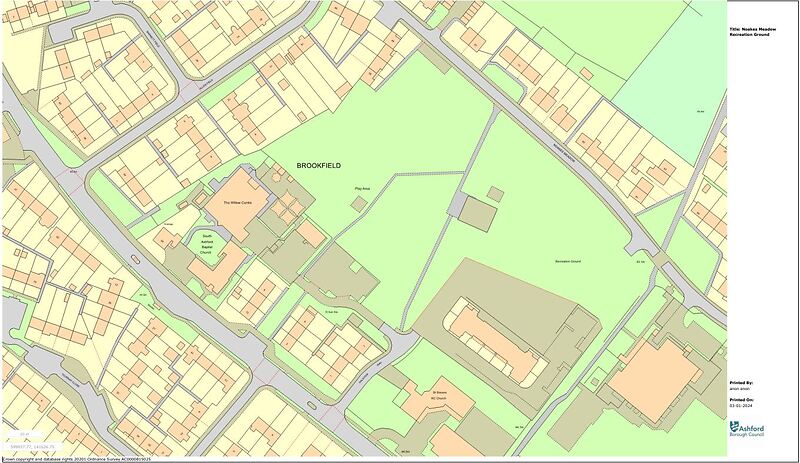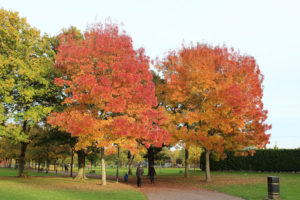1.1 South Ashford Community Forum
South Ashford Community Forum (SACF) is an open forum set up to represent the views of people living and working in the unparished area of South Ashford and to help communicate those views to Ashford Borough Council (ABC), Kent County Council (KCC) and other statutory organisations. It is an independent voluntary group with its own constitution.
Any reference to South Ashford in this submission relates to the area served by SACF.
1.2 Parks and open spaces in Ashford
South Ashford includes the following public parks and open spaces:
- Victoria Park: A semi-formal urban park, a short walk from the town centre, originally purchased by Ashford Borough Council’s predecessor in 1898. Trees and furniture originally commemorated eminent townspeople. The Grade II* listed Hubert Fountain is located in the park. The Park incorporates laid out paths, open grass, some flower beds and children’s play areas. The Stour Valley cycle/footway passes through the park together with some secondary transit routes. A indoor bowls club building has been built in the park and a children’s nursery occupies another building.
- Watercress Fields: A large open space, stretching westward along the River Great Stour from Victoria Park, to the boundary of the unparished area. Part of the Stour Valley cycle/footway runs through Watercress Fields. Although mainly open grass, small wooded areas, meadow and river bank environment are also present. A Community Orchard has been created within the space.
- Bowens Field Wetlands: An area constructed as surface water storage to the East of Victoria Park, in 1990, modified and planted to create a wetland area in 2004.
- Open spaces, designated in the Local Plan, at Noakes Meadow, Cryol Road, St. Anne’s Road, which include play parks and/or multi-use games areas, and at Cleves Way, Knoll Lane and Musgrove.
- Non-designated open space created in the planning of the housing estates of South Ashford.
1.3 Ashford’s Green Corridor
Victoria Park, Watercress Fields and Bowens Field form part of Ashford’s Green Corridor, a linear area of parks, recreation grounds and other green spaces alongside the River Great Stour and its tributaries flowing through Ashford. In addition to recreational space, being adjacent to the River Stour the Green Corridor is a major area of flood protection, most of which is designated as a local nature reserve. The Green Corridor is protected by ABC planning policies.
1.4 Ashford Borough Council policy
1.4.1 Corporate Plan
In Corporate Plan adopted by ABC in October 2015, Priority 4 is
“Attractive Ashford: Countryside and Townscape, Tourism and Heritage”.
The stated aspiration attached to this priority is:
“To achieve an environment that creates higher standards of public space design, alongside improved standards of presentation of key green spaces.
“To safeguard and conserve our local heritage and areas of outstanding landscape quality to ensure the very best attractive environment with thriving and vibrant town centres”.
Included in the actions attached to the policy are
“Improve and safeguard the quality and presentation of the borough, recognising its unique environment, countryside, local heritage and tourism offer”:
- Create Landscape Action Team and implement higher maintenance standards. Respond to growth and associated land management issues through quality, flexibility, control and cost management.
- Bring forward a new green corridor action plan to improve presentation, signage, planting and better water quality.
“Delivery of best mix of new and existing parks and green spaces, incorporating quality public art and cutting edge design”:
1.4.2 In-house Landscape Management
From October 2016, ABC will be bringing the responsibility for grounds maintenance across the borough back in-house. ABC have said “this initiative is a key part of delivering the adopted Land Management Improvement Plan, which aims to make the borough a pleasant and enjoyable place to live, work, visit and enjoy.
“The new in-house service will give us greater flexibility as we will be able to move resources where they are needed most, with an ability to be more fluid with changing priorities. It will also be more cost effective.”
1.4.3 Planning Policy
ABC’s current Local Development Framework includes a number of policies relating to creation and maintenance of open space and a Supplementary Planning Document, Public Green Spaces and Water Environment.
ABC’s Draft Local Plan, for which the Regulation 19 consultation has recently been completed, incorporates similar policies into the single Local Plan document. There is, inevitably, less detail than contained in the current plan. The Draft Local Plan does however refer to a separate Green Corridor Action Plan that has not yet been published.
1.4.4 Victoria Park and Watercress Fields Masterplan
In September 2015, ABC Officer, Chris Dixon, gave a presentation to SACF outlining proposals to produce a management plan for Victoria Park. This resulted in a creation a Concept Masterplan for improvements to Victoria Park and Watercress Fields together with proposals for an Application to Heritage Lottery Fund for finance to implement part of the Masterplan which included the refurbishment of the Hubert Fountain.
In March 2016 ABC’s Cabinet resolved that:
(i) the Victoria Park and Watercress Fields Concept Masterplan be adopted as an indicative framework to support the future planning of new development, refurbishment and timely partnership working as opportunities arise.
(ii) the first stage application to the Heritage Lottery Fund with a Council contribution of up to £10,000 be endorsed and a further report be brought forward in due course to consider the second stage application.
The HLF first stage application was, however, unsuccessful.



